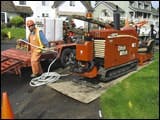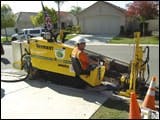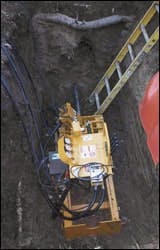- Ditch witch
- TT Technologies
- Straightline
- Astec Underground
- Vermeer
- McLaughlin
- Estimated Operating Costs Of Compact HDD Equipment
- HDD Specifications (less than 20,000-lb. pullback)
After several difficult years, times appear to be good again for the horizontal directional drilling (HDD) industry. Contractors have work, and equipment manufacturers are selling drilling equipment and support products. Although few go so far as labeling the resurgance of the horizontal direction drill from the depression of the early 2000s a new "boom," the market is closing 2006 on a strong note and prospects for 2007 are encouraging.
Although big projects where large drilling units install thousands of feet of large-diameter pipe continue to attract attention, most trenchless installations by directional drilling actually are made by much smaller models.
The most recent Universe of Construction Equipment study conducted by Construction Equipment magazine found that 62 percent of the active HDD population is comprised of equipment rated at 20,000 pounds of pullback or less, and drilling units in that category are the subject of this report.
Currently, six manufacturers offer 15 HDD models in this class, ranging in pullback ratings from 5,000 to 20,000 pounds. Thirteen are track machines, two are skid-mounted, pit-launch models. All of these products pack a surprising amount of power in small packages.
The rebounding telecommunications market, and especially accelerated projects to deploy fiber optic networks to bring broadband services to new customers, is given much of the credit for increasing demand for directional drilling. Many fiber-to-the-premises (FTTP) projects are in established neighborhoods where excavation is impractical, impossible or sometimes prohibited.
Horizontal directional drilling is the perfect solution in such situations, and contractors are talking full advantage of the technology to bring services from curb to home or building. Most of these installations are less than 100 feet in length to bury small-diameter conduit in which fiber optic cable is placed.
"Limiting excavation is the key," says Ed Savage, underground segment manager for Vermeer. "That translates into less restoration costs, less closed driveways, less closed streets, less closed sidewalks, less disturbed landscaping, and happier homeowners."
There even are instances where property owners demand trenchless construction — once a compact drill unit has worked in a neighborhood, trenchers and even vibratory plows are not welcome there, and residents may pressure project owners and contractors to install services trenchlessly.
Although much attention is focused on the benefits of compact machines for FTTP construction, their value is not limited to only those projects. Compact HDD equipment is active on a variety of projects, including extending electrical-distribution and natural-gas-distribution systems, replacing old power cable and gas pipe, and installing water service lines and sewer laterals.
Several new model designations in the machines in the 20,000-pound-and-less class have been introduced. But basic designs and key components of compact drill units have not changed in the past several years, and some of the features considered standard on mid-range equipment — on-board pipe racks, automatic pipe make up and removal — are not available on some smaller models. However, manufacturers continue to refine those designs, enhancing already-proven products that have the capabilities needed by the marketplace.
Exceptions of note: Digital Control Inc. (DCI) and Vermeer recently unveiled a new electronic tracking system developed specifically for Vermeer's compact 5,500-pound pullback drilling unit. And while pit-launch HDD units have been available for several years (CE covered the product category in 1998), they have not been widely used. They now appear to have found a new niche on FTTP jobsites with extremely limited space.
Manufacturers offer the following comments about compact-drill units and how they are being used:
Astec Underground (two HDDs under 20,000 pounds pullback), Gaylord Richey, territory manager: "These small, compact packages allow quick set up in tight working conditions, but have plenty of power to get the job finished in a timely manner. They also require smaller support packages, vehicles, trailers and crews, which makes them more marketable for the residential neighborhoods. When comparing brands and models, buyers should consider size-to-power ratios; thrust, pullback and torque; size of footprint; ease of operation; safety features; and weight for transporting."
Ditch Witch (four HDDs with pullback of 20,000 pounds or less), Richard Levings, senior product manager: "Which compact model is used depends on job requirements and space available for setup. Smaller models are used in tight spaces and installations from house to curb, larger units are better in difficult soil conditions and for longer runs two blocks or more. Some features are left off small models because they add weight and size and really aren't needed. It also keeps costs down."
McLaughlin Group (one pit-launch HDD), Dave Gasmovic, president: "Small, mini-directional rigs are ideally suited to residential fiber installations, but pit-launched models, although more labor intensive in terms of setup and restoration, are an extremely viable alternative when right-of-way restrictions prohibit the use of a surface-launched unit.
Some pit-launched systems allow for the use of multiple drilling methods, not possible with a surface-launched unit, while affording the operator comparable power. Pit-launch versions use the same fluid assist method and also are capable of using an auger and a rotary percussion bit for rock conditions. The system can operate dry or with drilling fluids."
StraightLine (one 20,000-pound pullback HDD), Don Cary, president: "The 20,000-pound machine is a good size for many projects. It provides a lot of horsepower that translates into more work with a machine that weighs less and fits in smaller spaces than medium-size models. There is a significant amount of FTTP construction, but there also are new levels of work for gas, power, force sewer systems, and small pipeline construction. We believe this is the foundation for the future of HDD."
TT Technologies (one track-mount and one pit-launch HDD with pullback of 20,000 pounds or less), Chris Brahler, president: "Keeping the environmental impact to a minimum is always a benefit of using compact drills, and the demand for the smaller rigs of 20,000 pounds or less has been really strong and growing — they are very powerful and versatile. Pit-launch units are used when going building to building. They are great for inner city jobs."
Vermeer (five HDDs with pullback of 20,000 pounds or less), Ed Savage, underground segment manager: "Compact HDD equipment is suited for any job requiring short (typically 500 feet or less) installation of small-diameter product (4 inches or less). Such jobs include not only fiber deployment, but water, electric, cable television, and sewer laterals. The new DCI DigiTrak LT is a cost-effective HDD tracking system for use with our 5,500-pound pullback drill unit for making the short, relatively shallow installations associated with deployment of fiber systems to end-users."







